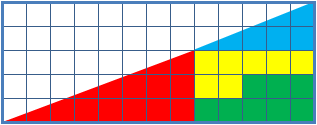 |
| By Krauss (Own work) [CC BY-SA 4.0 (http://creativecommons.org/licenses/by-sa/4.0)], via Wikimedia Commons |
 |
| By Trekky0623 at English Wikipedia (Transferred from en.wikipedia to Commons.) [Public domain], via Wikimedia Commons |
Learning and teaching physics through cognitive conflicts: science puzzles and paradoxes becoming challenging teasers
 |
| By Krauss (Own work) [CC BY-SA 4.0 (http://creativecommons.org/licenses/by-sa/4.0)], via Wikimedia Commons |
 |
| By Trekky0623 at English Wikipedia (Transferred from en.wikipedia to Commons.) [Public domain], via Wikimedia Commons |
No extra surface is obtained. If you overlay the starting image and the final image you can see the coloured blocks occupy more space.
ReplyDeleteGood!
DeleteBut a further explanation is needed. In pictures A and B every shape that is coloured in in the same way is made exactly of the same squares, with all the lengths being the same. In addition, the catheti of whole triangle in B picture are exactly the same as the catheti in A picture. So what is the loophole?
The key is the slope of the hypotenuses. Both triangles seem to have the same slope, but they don't, we can see (counting squares) that the blue one has a slope of 2/5 (0.4) while the red one has a slope of 3/8(0,375). That means that the complete figure is not a triangle, being figure A smaller and B bigger than the "ideal" triangle.
ReplyDeleteVery good!
DeleteThis cognitive conflict is suitable in order to introduce the concept of slope in freshman year (9th grade). It is called the missing square puzzle.